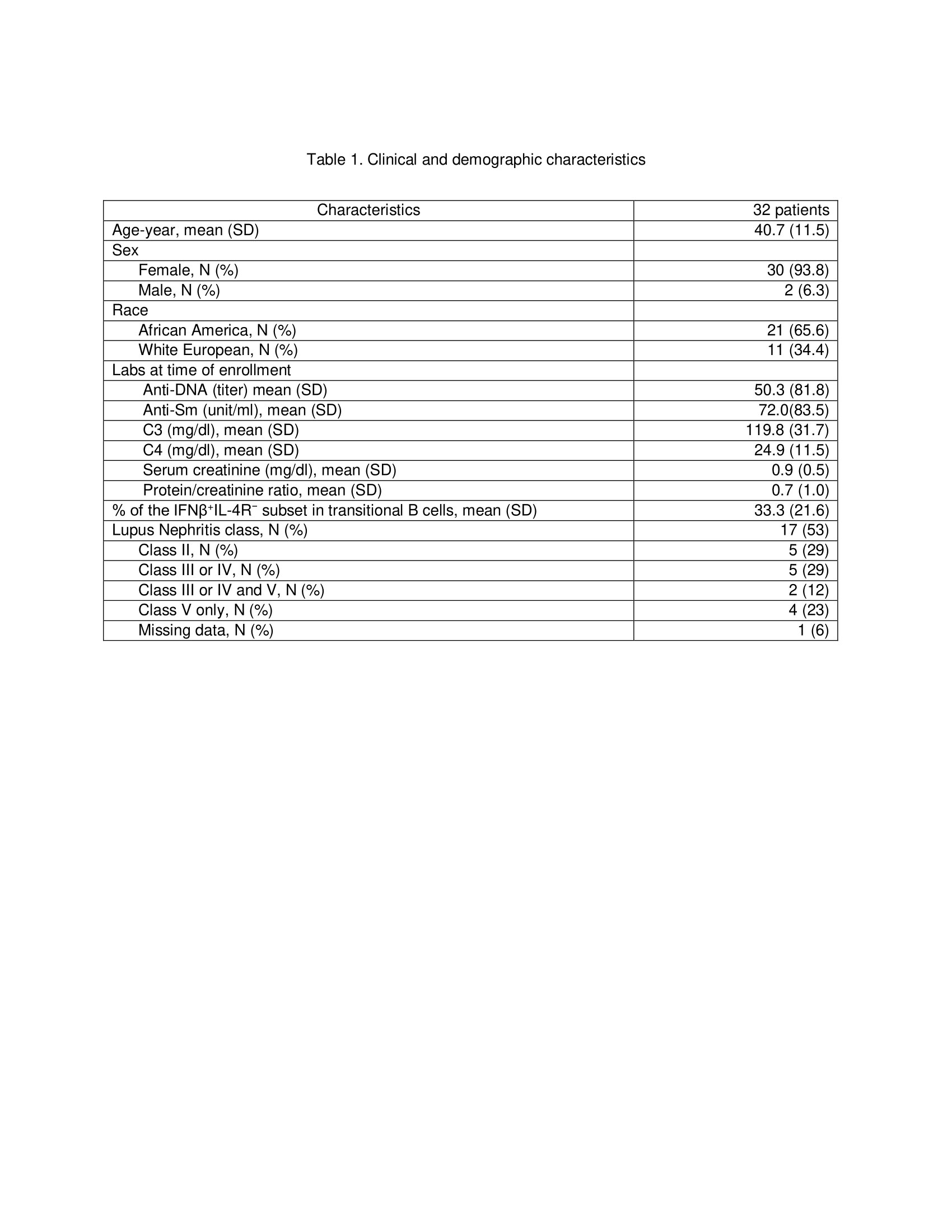Session Information
Session Type: Poster Session A
Session Time: 9:00AM-11:00AM
Background/Purpose: We previously showed that B-cell endogenous interferon-beta (IFNβ) at the transitional (Tr) stage correlates with development of anti-Smith (anti-Sm) and renal disease as well as African American (AA) race. We recently identified that down regulation of IL-4 receptor (IL-4R−), a resting B-cell marker, is another phenotype of pathogenic B cells in SLE. This study determined if the Tr B-cell activation phenotype characterized as “IFNβ+IL-4R−“ correlated with anti-Sm and can be a useful prognostic marker for autoantibody, renal disease (RD), and histopathologic features of lupus nephritis (LN).
Methods: The expression of IL-4R and interferon beta (IFNβ) in subsets of B cells was analyzed using flow cytometry analysis in 47 patients diagnosed with SLE. Plasma was assayed for IgG anti-Sm/RNP and anti-DNA using a standard ELISA method. Charts of 32 patients among these were reviewed and included in this analysis (30 were female and 21 patients were AA). Serologic manifestations of SLE included anti-DNA, anti-Sm, C3, and C4. Clinical laboratory manifestations of RD included creatinine and urine protein/creatinine ratio. RD classification was diagnosed based on the revised ISN/RPS (2004) criteria (16 patients) and included renal histopathology microscopy findings on light, electron microscopy and immunofluorescence (IF) for deposit of IgM, IgG, IgA, light chain, C1q and C3 (9 patients).
Results: Higher expression of IFNβ and lower expression of IL-4R at the Tr stage correlated with their expansion in naïve B cells and plasma levels of anti-Sm/RNP. Among the 32 patients analyzed 17 (53%) patients were diagnosed with LN. At the time of B cell phenotype analysis, 8 (25%) of patients were positive with anti-DNA, and 20 (62%) of patients were positive with anti-Sm. Multivariate regression analysis indicated a significant positive correlation between the IFNβ+IL-4R− phenotype with anti-Sm (p=0.0035), anti-DNA (p=0.0234), low C3 (p=0.0360) and high protein creatinine ratio (p=0.0246). RD classification revealed Class II in 5 (29%) patients, Class III or IV in 5 (29%) patients, Class III or IV with Class V in 2 (12) patients and Class V only in 4 (23 %) patients. Direct IF examination of LN biopsies revealed that patients with higher percentage of the Tr B cell IFNβ+IL-4R− phenotype also exhibited increased deposition of IgM, IgA, and C1q, but not IgG and C3 especially in glomerular mesangium compared to tubular basement membranes and arteries.
Conclusion: These results suggest a sequence for immunopathogenesis in SLE which is initiated as IFNβ+IL-4R− activated B cells at the earliest Tr stage of development. These B cells are predisposed to undergo tolerance loss, especially to the Sm autoantigen. This is highly correlated with development of renal disease and low C3 consistent with previous studies. Association of the circulating IFNβ+IL-4R−B cell phenotype with immunofluorescence staining for IgM, IgA, C1q, but not IgG or C3 suggest distinct mechanisms of inflammation in the kidney compared to systemic inflammation. Our results suggest that restoration of B cells into the resting status at the Tr stage either through blocking INFβ or the type I IFNR, and/or optimizing IL-4R signaling may prevent or improve RD in SLE.
To cite this abstract in AMA style:
Alduraibi F, Fatima H, Chatham W, Hsu H, Mountz J. Endogenous Interferon-β and Low IL-4R on Transitional B Cells Promotes Lupus Nephritis [abstract]. Arthritis Rheumatol. 2020; 72 (suppl 10). https://acrabstracts.org/abstract/endogenous-interferon-%ce%b2-and-low-il-4r-on-transitional-b-cells-promotes-lupus-nephritis/. Accessed .« Back to ACR Convergence 2020
ACR Meeting Abstracts - https://acrabstracts.org/abstract/endogenous-interferon-%ce%b2-and-low-il-4r-on-transitional-b-cells-promotes-lupus-nephritis/

